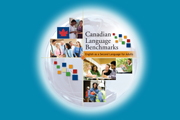
Self-Assessments
The LFS Self-assessments were created to help learners and employees better understand their own language skills within a workplace context. The self-assessments are based on the CLB and SFS, and they give learners and employees an approximate idea of what language level they can use in a workplace context. They can also help learners and employees identify which LFS learning activities they should begin with.
The self-assessment tool guides learners through each level or stage. When learners reach the limit of their abilities, they can estimate that this is their LFS level or stage.
The language skills of Communication (Listening and Speaking), Reading, and Writing align the CLB with each SFS level and provide examples of language used in that context in a workplace setting.
Like the Can Do Statements, each self-assessment indicator aligns with one of the four competency areas in the CLB. See the Can Do Statements for more information around this.
The other skills of Adaptability, Collaboration, Creativity and Innovation, Digital, Numeracy, and Problem Solving align the CLB stage with the SFS components and provide examples of language used in that context in a workplace setting.
Like the Can Do Statements, each self-assessment indicator aligns with one of the six components in the SFS. See the Can Do Statements for more information around this.
The Self-Assessments can be used by:
- Learners and employees to help them understand what they have already accomplished and find information to support them as they set their next language learning goals.
- Instructors as an informal check for the achievements of learners and to support goal setting.
- Employers to better understand the workplace language needs of employees.
The LFS Self-assessments cannot be used for formal language assessment because they do not include any test prompts, items, or indicators. The tool does not include the level of detail needed to support formal language assessment.


















